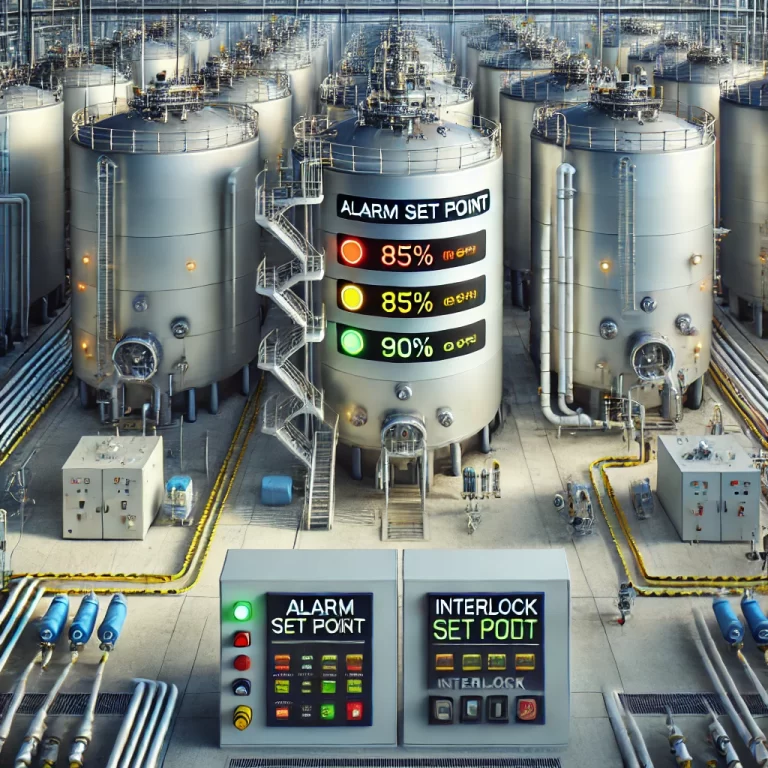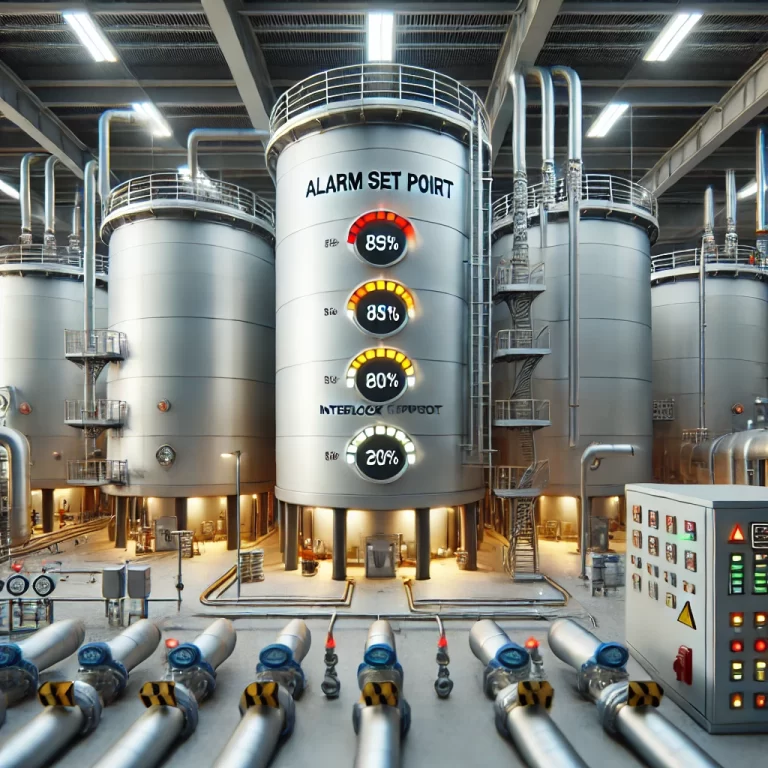The configuration of alarm and interlock set points in storage tanks is a critical aspect of industrial process safety and efficiency. Understanding the relationship between these two parameters is essential for ensuring safe and reliable operations. This article will explore whether it is reasonable for the interlock set point to be lower than the alarm set point in storage tanks by discussing their functions, standard design practices, and conditions under which such a configuration might be justified.
1. Understanding Alarm and Interlock Set Points
Alarm Set Point (ASP): An alarm set point is configured to alert operators when a process variable, such as pressure, temperature, or liquid level, approaches a potentially hazardous condition. The primary goal is to prompt human intervention to prevent the situation from worsening. Alarms serve as an early warning system that allows operators to correct deviations before safety systems engage.
Interlock Set Point (ISP): An interlock set point, on the other hand, is designed to automatically trigger protective actions when a process variable reaches a critical threshold. This could involve shutting down equipment, closing valves, or initiating emergency procedures. Interlocks operate independently of human intervention to prevent catastrophic failures or unsafe conditions.

2. Standard Design Logic
In typical industrial practice, the alarm set point is configured to trigger before the interlock set point. This sequence provides operators with a window of opportunity to take corrective measures before automatic safety systems engage. For instance:
High-Level Scenario:
High-Level Alarm (HLA): 85% full
High-High-Level Interlock (HHLI): 90% full (automatically stops filling operations)
Low-Level Scenario:
Low-Level Alarm (LLA): 20% full
Low-Low-Level Interlock (LLLI): 15% full (automatically stops discharge operations)
This arrangement ensures that operational disruptions are minimized and that emergency shutdowns occur only when absolutely necessary.
3. Is It Reasonable for the Interlock to Be Set Lower Than the Alarm?
Setting the interlock set point lower than the alarm set point deviates from standard safety practices. However, certain conditions may justify this configuration:
Process-Specific Safety Requirements: In processes involving highly volatile or hazardous materials, immediate automatic action may be prioritized over operator intervention. An interlock could be triggered at a less critical point to preemptively mitigate risks, with the alarm acting as a confirmation rather than a warning.
Fail-Safe Design Philosophy: Some systems are designed to default to a safe state as early as possible. In such cases, the interlock may engage at a lower threshold to ensure the system shuts down or diverts flow before reaching more dangerous levels.
Complex Process Dynamics: In certain processes with rapidly changing conditions, operators may not have sufficient time to respond effectively. Here, an interlock might be set to activate before an alarm to quickly contain the issue.
4. Risks and Concerns
Despite potential justifications, setting the interlock lower than the alarm can introduce several issues:
Reduced Operator Control: Automatic intervention may occur before operators are even aware of a developing issue, limiting their ability to manage the situation.
Unnecessary Shutdowns: Frequent or premature interlocks could disrupt operations, leading to unnecessary downtime and financial losses.
Deviation from Industry Standards: Safety regulations and industry best practices generally require alarms to precede interlocks. Deviations may raise compliance and safety concerns.

5. Best Practices and Recommendations
Risk Assessment: Conduct a thorough risk analysis (e.g., HAZOP or SIL assessment) to determine the most appropriate configuration for alarm and interlock set points.
Adherence to Standards: Follow industry guidelines such as IEC 61511 for safety instrumented systems to ensure safe and compliant operations.
Operational Testing: Regularly test and validate both alarms and interlocks to confirm they perform as intended under various operating conditions.
Operator Training: Ensure that operators understand the function and sequence of alarms and interlocks to respond effectively during abnormal situations.
Conclusion
In most industrial settings, it is not advisable for the interlock set point to be lower than the alarm set point, as this can compromise safety and operational control. However, specific process requirements or safety philosophies might justify such a configuration. A careful balance between automated protection and human intervention, guided by comprehensive risk assessments and adherence to safety standards, is essential for maintaining both safety and efficiency in storage tank operations.
